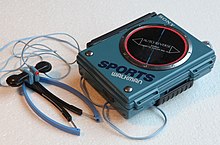
A personal stereo, or personal cassette player, is a portable audio player for cassette tapes. This allows the user to listen to music through headphones while walking, jogging or relaxing. Personal stereos typically have a belt clip or a shoulder strap so a user can attach the device to a belt or wear it over their shoulder. Some personal stereos came with a separate battery case.
History
The Sony Walkman was released in 1979, created by Akio Morita, Masaru Ibuka (the co-founders of Sony) and Kozo Ohsone. It became a popular and widely imitated consumer item in the 1980s. In everyday language, walkman became a generic term, referring to any personal stereo, regardless of producer or brand. [1] The spread of personal stereo devices contributed to tape cassettes outselling vinyl records for the first time in 1983. The introduction of the personal stereo coincided with the 1980s aerobics vogue, making it very popular to listen to music during workouts. Moreover, the prevalence of portable cassette players correlates with a 30-percent increase of people walking for exercise between 1987 and 1997. [2]
In the 1990s, portable CD players became the most popular personal stereos. In the 2000s, digital players like the iPod became the dominant personal stereos. During this period, cell phones and smartphones also became popular music listening devices.
References
- ^ Mark Batey (2016), Brand Meaning: Meaning, Myth and Mystique in Today's Brands (Second ed.), Routledge, p. 140
- ^ Meaghan Haire (1 July 2009). "The Walkman". Time.
Further reading
- Erlmann, Veit (ed.) Hearing Cultures. Essays on Sound, Listening, and Modernity, New York: Berg Publishers, 2004. Cf. Chapter 9: "Thinking About Sound, Proximity, and Distance in Western Experience: The Case of Odysseus's Walkman" by Michael Bull.